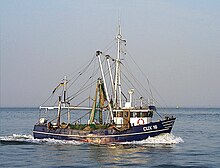Fishing license
The fishing license plate , also known as the fishing number, is a mandatory optical identification on the bow of sea fishing vessels ; usually two are required at the bow. The license plate consists of a sequence of one to five letters that designate the home port , followed by a registration number. These vehicles, however, are exempt from having an IMO number .
The basis for the use of a fishing license is the international treaty concluded on May 6, 1882 in The Hague for the regulation of fisheries in the North Sea by the neighboring states. Among other things, it contained the obligation of the participating states to keep lists of these labels. Conversely, this meant that all vessels, if they wanted to be allowed in the fishery, had to apply for such a registration and were subsequently clearly identifiable.
- Example: Nauke HF 17 fishing vessel .
- Accordingly, the Nauke comes from Hamburg-Finkenwerder and is the seventeenth fishing vessel registered there.
The agreed obligation was introduced in Germany after the announcement in the Reichsgesetzblatt in 1884 under the heading "Police regulation of deep-sea fishing in the North Sea".
However, there are fishery labels not only in the North Sea , but also around the world for neighboring seas, for example in Algeria , France (e.g. NI for Nice , PL for Paimpol ), Spain (e.g. PM-3 for Palma ) and Japan (e.g. HKI for Hokkaidō ).
Overviews
- Belgium
- Denmark
- Germany
- Faroe Islands
- Finland
- France
- Great Britain
- Ireland
- Iceland
- Netherlands
- Norway
- Poland
- Portugal
- Spain
literature
- Heinz Linde, Willi Luther , Willy Moor: Sea fishing . Urbes Verlag, Munich 1998, ISBN 3-924896-37-2 .

